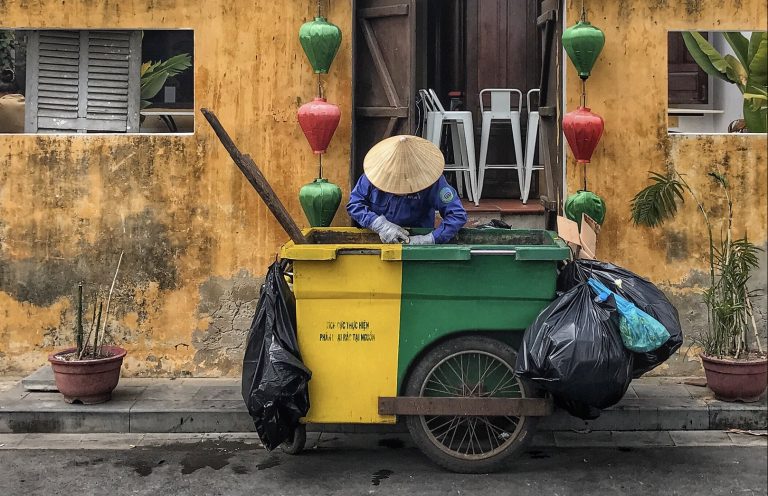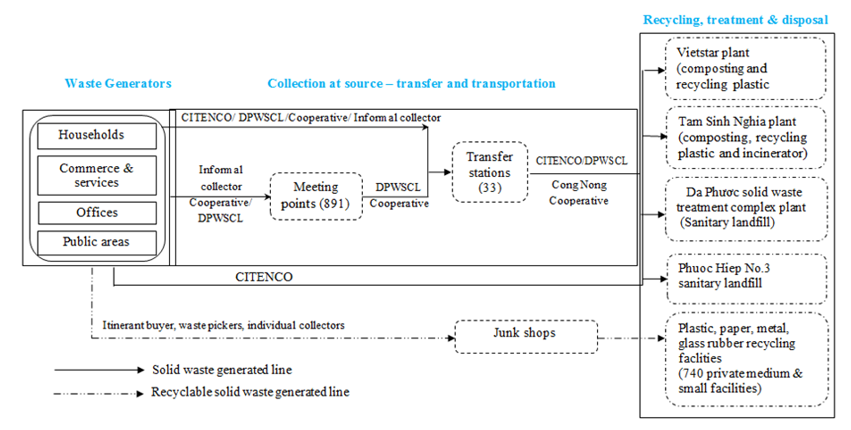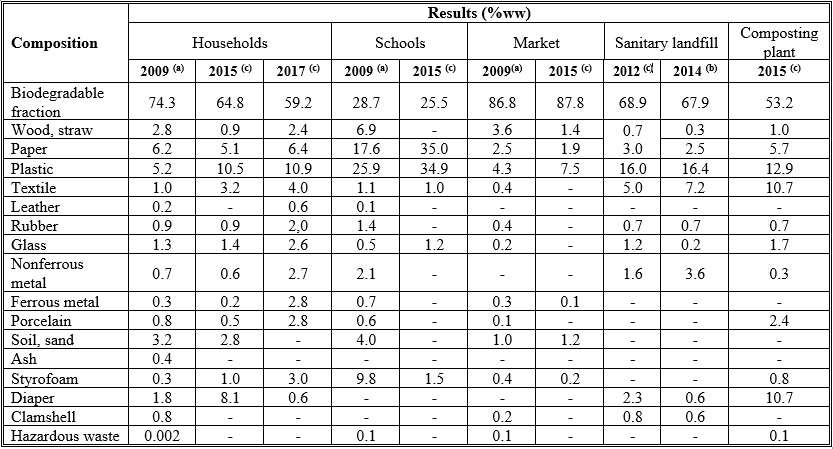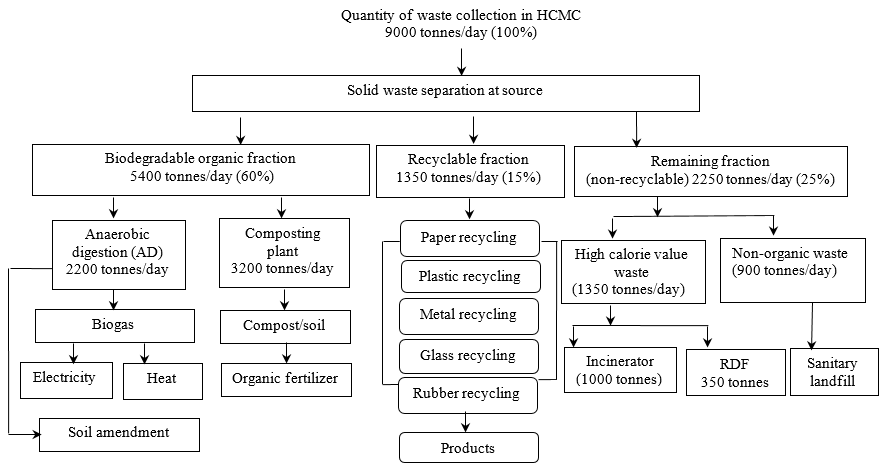
Challenges and opportunities to approach zero waste for municipal solid waste management in Ho Chi Minh City
Keywords
Biogas · Composting · Landfill · Municipal solid waste · Solid waste separation at source · Zero waste
Highlights
- Lack of infrastructure and appropriate source segregation are major issues.
- Waste composition from households/markets indicates more than 60% biodegradable organic fraction.
- Waste segregation plays a vital role in solid waste management.
- Composting and anaerobic digestion seem to be feasible for biodegradable organic fraction.
- Value materials recovery and incineration for high heating value waste can be adopted.
1. Introduction
Ho Chi Minh City (HCMC) is a mega city with a total area of 2,095 km2. HCMC has 24 districts, 19 urban and 5 rural. The total population is more than 10 million, with a growth rate of 10.2% (Viet, 2013). According to the social report of HCMC in 2016, the average gross domestic product (GDP) per capita was 5,700 USD (HCM People’s Committee, 2016). The accelerated economic growth and rapid urbanization have resulted in serious Municipal solid waste (MSW) management problems.
The quantity of solid waste generated has been increasing significantly from 1992 to 2017 (Figure 1). In 2017, the total waste generated was about 8,845 tonnes/day (Department of Natural Resource and Management-Ho Chi Minh City [DONRE], 2016). From 2010 to 2017, the solid waste growth rate was about 6–8% per year, with an average solid waste generation of about 1.07 kg/capita/day (DONRE, 2016). In addition, segregation at source is not widely practised. Therefore, MSW management has been considered as one of the most severe environmental problems as the quantity of waste has increased while infrastructure for collection and treatment is not sufficient. The Government of HCMC has given priority to the problem and is interested in promoting effective and appropriate technology in solid waste management. The objective of this research is to propose sustainable resource utilization techniques in the rapidly urbanizing city. Challenges and opportunities to address this issue are discussed in the paper.

2. Methodology
2.1 Baseline data collection
Collection of baseline data was undertaken between October 2014 and June 2015. Both primary and secondary data were collected from relevant sources. Data includes characteristics of waste, generation rate, options for waste management, and disposal technology, including any reuse/recycling practices adopted.
2.2 Solid waste management option identification
Challenges and opportunities were identified in order to draw management options. These options were based on the current situation, composition, government policies, facilities, technical skills, and financial resources.
3. Results and Discussion
3.1 Current situation of municipal solid waste management in Ho Chi Minh City
The current solid waste management system of HCMC is shown in Figure 2. MSW is collected and transported directly or via transfer stations to sanitary landfills or composting plants. Recyclable waste is separated during the collection process at the source (households, offices, schools, and business units) by residents and informal collectors.
According to DONRE HCM (2016), the collection rate of MSW in HCMC achieved 100% in inner city areas and 95% in suburban areas. At present about 68.6% of collected solid waste is disposed of in sanitary landfills, 24.5% of collected solid waste is disposed of in compost plants, and 5.7% in incinerators.

3.1.1 Generation and storage
Generation sources of MSW are residential areas with 2 million households, 346 business units, 354,661 units of hotels/motels, 12,502 medical units, 4,730 offices, education and training organizations, and about 12,000 industrial factories and enterprises. Households generate 57.9% of MSW (DONRE, 2011).
At present, no separation of MSW takes place at the source. However, most households separate valuable waste such as cans, plastic, paper, etc., from their waste and sell to waste buyers. In general, the critical points related are the high amount of commingled solid waste generated, no standard containers for storage, limited space in households for placing containers, high amount of leachate and malodour generation, and lack of public awareness.
3.1.2 Solid waste collection and transportation
Collection, transfer and transportation of solid waste in HCMC are carried out by two systems: public and private systems. The public system consists of HCMC City Urban Environment Company Limited (CITENCO) and 22 District Public Work Service Company Limited (DPWSCLs). The private system consists of informal collectors and cooperatives. Collectors in the private system collect 60% of solid waste while those from the public system collects the remaining 40%.
One major problem is that collection equipment is not standardized. This is especially true for equipment used by informal collectors. Other problems include narrow transport pathways in dense areas; non-standardized collection facilities and lack of safety facilities; lack of collection skills and the practice of separating recyclable waste, which causes delays in collection time and generates pollution; lack of monitoring and control; and non-integrated management.
HCMC has 33 transfer stations with a total design capacity of 5,477 tonnes/day. According to the annual report of DONRE (2014), 100% of waste generated was collected, transferred and transported. However, waste transfer and transportation is complex and inadequate for the following reasons: (1) there are many companies involved in this activity and who work independently from each other making it difficult to organize and integrate the transport activities and routes; (2) inadequate infrastructure, such as narrow and poorly paved routes, non-standardized collection cars/trucks, lack of meeting points and transfer stations; (3) lack of tools, guidelines, regulations to support the waste transport system; (4) poor management capacity; and (5) insufficient funding.
3.2 Waste characteristics
The survey results from 2009 and 2017 show that different sources have different waste characteristics (Center for Environmental Technology and Management [CENTEMA], 2009; CENTEMA, 2017). Most of the fraction is biodegradable organic fraction. Recyclable fraction varies depending on the source, as shown in Table 1. In addition, household hazardous wastes (HHW) are also present in MSW.

3.3 Solid waste reuse and recycling
Based on the characteristics, composting and recycling of valuable materials are adopted in the study.
3.3.1 Composting
At present, there are three composting plants: (1) Vietstar with a capacity of 1,200 tonnes MSW/day; (2) Tam Sinh Nghia with a capacity of 1,000 tonnes MSW/day; and (3) Vietnam Waste Solution (VWS) Company with a capacity of 1,000 tonnes MSW/day. If three composting plants were to run at full capacity, 100% of the biodegradable organic fraction of generated MSW would be treated to produce compost. However, VWS Company is not operating because solid waste is not separated at source. The input of two composting plants is commingled waste and therefore, the separation process has to take place after transport, which is complex, costly and requires a lot of labour. An abundant component in MSW is plastic, which needs to be removed before the waste is composted. At Vietstar and Tam Sinh Nghia plants plastics are separated, cleaned and processed into plastic pellets, which contribute to the income of the plant.
At the Vietstar and Tam Sinh Nghia plants aerated static pile composting (windrow composting) technology is used. Currently, the capacity of the Vietstar plant is 1,200 tonnes/day, in which 773 tonnes of solid waste are for composting, 7 tonnes of solid waste is recyclable plastic, and 420 tonnes are non-recyclable materials for disposal at the Phuoc Hiep No.3 sanitary landfill. The capacity of the Tam Sinh Nghia plant is 1,000 tonnes/day, in which 350 tonnes/day is for composting, 50 tonnes/day for recycling plastic, and 600 tonnes/day for incineration (DONRE, 2015). As mentioned, the input of all composting plants is commingled waste; thus the compost product contains amounts of hazardous household waste, glass and plastic, which results in a decrease in the quality of compost making it very difficult for market sale. For this reason, poor quality compost is used for levelling sulphate contaminated areas to improve the landscape and soil quality.
3.3.2 Recycling
The amount of recyclable waste collected is about 1,400 to 1,800 tonnes per day (Nguyen, 2015). The recyclable waste such as plastic, paper, glass, and metal are collected at several stages of the collection chain at households, at meeting points, during transport and at composting plants. After separating the recyclable from households, the waste is sold to waste buyers first, and then to junk shops followed by selling to large junk shops or recycling facilities. Most of this recyclable waste is processed by local recycling facilities and some recyclable waste, such as plastic and metal, are exported to China (Nguyen, 2015). Additionally, recyclable waste is sent from other cities and provinces in the vicinity for processing. HCMC has about 1,100–1,200 junk shops and 740 recycling facilities that recycle about 2,000 tonnes of recyclable waste per day. This system also creates jobs for 16,000–18,000 unskilled labourers.
3.4 Solid waste disposal
The ratio of MSW disposed at sanitary landfills accounts for about 68% of total solid waste collected. This is higher than the target in the HCMC 5-year plan (2010-2015), which is 40%. At present, two sanitary landfills are in operation. First, Da Phuoc solid waste treatment complex, owned by California Waste Solution Company, operates at a capacity of 5,000 tonnes/day (increasing from 3,000 to 5,000 tonnes/day in 2015). Most of the solid waste generated in HCMC is transported to Da Phuoc sanitary landfill for disposal. Second, Tay Bac Cu Chi solid waste treatment complex owned and managed by CITENCO, operates at a capacity of 2,000 tonnes/day. This landfill receives the remaining solid waste from the Vietstar plant. Both landfill sites are designed as sanitary landfills.
However, inhabitants have filed complaints regarding odours and the quality of effluent discharged from treatment systems as they do not meet effluent standards of Vietnam.
3.5 Challenges and opportunities for sustainable solid waste management
3.5.1 Challenges
Major challenges in the current MSW management system are presented in Figure 3. Due to low public awareness, waste segregation is a major challenge. As such, most of the MSW is currently not separated at source. Further, the absence of refuse bins for specific waste type (e.g. recyclable waste and organic waste) also hinders waste segregation. During waste collection by the informal sector, both recyclable and organic waste are dumped together into containers, which discourages people from segregating the waste.
Limited availability of technology is a major challenge in implementing solid waste management, and solid waste treatment technologies currently used are sanitary landfills (68.6%), compost production (24.6%) and incinerators (5.7%).
Financial constraints and a lack of human resources also present a major challenge in implementing solid waste management. The amount of revenue collected from the services provided by the municipality is less than the amount invested for collection, transportation and disposal of solid waste. Therefore, the current form of solid waste management is unsustainable in the long term.

3.5.2 Opportunities
The results from this study on MSW management in HCMC from 2009 to 2017 show that many opportunities exist for sustainable MSW management and are listed below:
- Biodegradable organic fraction is approximately 65% in domestic solid waste and, if it is well separated at source, it can be used as a raw material for compost or fermentation processing instead of disposing at the landfill.
- The potential agricultural demand for organic fertilizers and soil conditioners is very high and exceeds actual production capacity. High biodegradable organic fraction (64.8-74.3%), composting technology and anaerobic digestion technology with collection of biogas, is the most sustainable technology for the utilization of solid waste. Non-recyclable waste with high calorific value is suitable for incineration or refuse-derived fuel (RDF) technologies with an energy recovery system.
- The network for recycling activities is very large, including 740 private facilities recycling about 15-20% of MSW collected. Recyclable components including paper, plastic, and metal, can be recycled to create new products.
- In order to obtain pure biodegradable organic and remain fractions, solid waste separation at source (SWSAS) plays an important role in integrated solid waste management. Separating MSW at source can be applied at various levels through media campaigns and educational programmes. In Vietnam, there are many social organizations such as Women’s Union, Young Communist League, Veterans’ Union, and HCM young pioneer organization. These social organizations can play a leading role in the implementation of SWSAS programs.
- Vietnam has a policy to increase the use of green energy. The unit price for electricity produced from biogas is 7USD/kW and from incineration is 12 USD/kW. This policy can encourage the use of waste treatment technologies such as anaerobic digestion technology with biogas collection and incineration technology with energy collection.
- HCMC has established policies to support SWSAS programs, encouraging investment on technologies for recycling solid waste with energy recovery.
3.6 Set targets for MSW in HCMC from 2016 to 2025
According to the decision No. 491/QD-TTg dated May 7, 2018 on the adjustment of National strategy on integrated solid waste management for 2025 and vision for 2050, the Government of HCMC has developed a program to minimize environmental pollution for HCMC every 5 years. The targets of solid waste management in the period 2010-2015 were: sanitary landfill 40%, composting 40%, recycling 10%, and incineration 10%. However, these targets have not been achieved as they are too high when compared to infrastructure conditions, level of available technology, and human resources in HCMC. In June 2017, HCMC People’s Committee promulgated a Resolution on “Urban environmental protection and waste management in the HCMC” with targets of solid waste management to 2020. Following the Regulation, sanitary landfill technology will reduce to 60% and other technologies will increase to 40% including recycling of waste (paper, plastic, metal, glass, construction waste), incinerator, and biodegradable waste to produce compost and biogas. In 2025, sanitary landfill technology is expected to be 25%, with other technologies increasing to 75%.
According to the quantity and composition of generated solid waste and set targets for MSW in HCMC for 2025, the proposed solution for zero waste management is presented in Figure 4.

4. Conclusions and Recommendations
A proposed solution for a zero waste management system in HCMC for sustainable resource utilization is drawn based on the current situation, composition, national policies, and targets for MSW management. It can be adopted for reducing the amount of waste entering into landfill. The solutions are in line with the government policies and take into consideration socio-politic, environmental and economic aspects.
Based on the proposed solution, the majority of waste can be intercepted and converted to energy and compost. Recyclable fractions can be collected after effective source separation and this will benefit the participating community. Other incentive schemes such as shared-income, tax reduction or award systems, can be developed to ensure the sustainability of the project.
However, the proposed solution will be successful when government policies are directed towards sustainable waste management. The Government of HCMC should promulgate policies that will encourage recycling activities. Financial support should be provided to the recycling sector to improve existing recycling facilities or for investment in new facilities with advanced technologies. In terms of technologies, incineration, anaerobic digestion, and RDF are suitable options for MSW management in HCMC. The government should (1) promote a clear and simple investment regime; and (2) develop infrastructure that will merge energy generated from MSW into the national grid.
One of the main aspects to achieve waste management leading to zero waste is separation at source. For HCMC, the SWAS program is proposed and factors that will ensure successful implementation of the program are as follows:
- Increase the participation of authorities at all levels (city, district and ward) as well as social organizations.
- Ensure strong leadership for the implementation of SWAS.
- Issue legal documents to serve the SWSAS program that includes: (1) regulation on classification and storage at source; (2) collection at source and from streets; (3) transit and transport; (4) reuse and recycling; (5) policies; and (6) participation of social organizations.
- Establish a regulation on management of informal MSW collection sector, handling of waste by this sector, and punishment for violation. Effective management of informal collectors will contribute significantly to SWSAS program implementation.
- Capacity building programs for human resources involved in solid waste management should be developed and implemented. Strengthening capacity of staff at all levels, especially at community levels, can be of great value.
In addition, the public can play an important role in effective MSW management. They can play an important role in separating waste at source, waste reduction, and recycling, which are essential to achieve a zero waste management goal. In order to replicate the implementation of the project in other localities, lessons learnt from the implementation of the program in HCMC should be analysed and factors affecting successful implementation should be identified and adapted to local conditions.
Acknowledgement
The authors wish to acknowledge the financial support from the Asia-Pacific Network for Global Change Research (APN), Project reference: ARCP2015-12CMY-Sharp.
References
- Center for Environmental Technology and Management (2009). The report on data collection on solid waste management in Ho Chi Minh City, Vietnam.
- Center for Environmental Technology and Management (2017). The report on situation of solid waste management in Ho Chi Minh City, Vietnam.
- Department of Natural Resource and Management-Ho Chi Minh City (2009). Analysis of composition of municipal solid waste and amount generated solid waste from generators, the database of solid waste management monitoring program in Ho Chi Minh City in 2009.
- Department of Natural Resource and Management-Ho Chi Minh City (2011). Master plan (orientation) of the waste management system in HCMC to 2020 and Vision 2030 – Heading to the green management system.
- Department of Natural Resource and Management-Ho Chi Minh City (2014). Report on general data on situation of storage at sources, collection, transfer, transportation, treatment and disposal.
- Department of Natural Resource and Management-Ho Chi Minh City (2015). Report on the implementation result on minimization of environmental pollution in the period of 2011-2015.
- Department of Natural Resource and Management-Ho Chi Minh City (2016). Report on results of work in 2016 and work planning in 2017. Division of Solid Waste Management.
- HCM City People’s Committee (2016). Announced 10 outstanding events of Ho Chi Minh City in 2016. Retrieved 29 December 2016 from https://www.hochiminhcity.gov.vn/thongtinthanhpho/tintuc/Lists/Posrs
- Ngan, Truong (2018). Solid Waste Management in Vietnam Current situation, challenges and strategies for development (Metropolia University of Applied Sciences, Helsinki, Finland. Retrieved 3 November 2019 from https://pdfs.semanticscholar.org/1f24/1d964e060464f6bf599d28e6e6e66c4c17c9.pdf
- Nguyen, Trung Viet (2013). The economics for reuse – recycle activities of municipal and domestic solid waste in HCMC. Intramural magazine of Environmental Science and Sustainable Development. Faculty of Environmental Technology and Management, 3/2013: 14-21.
- Nguyen, Trung Viet (2015). Solid waste separation at sources program: Necessary and sufficient conditions for SWM in HCMC. Paper presented at International Conference on Technological and Management Solutions for Climate Change Adaptation: Opportunities and challenges to Asian Countries.